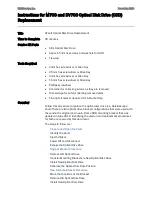
EonStorDS 1000 Series
67
Fibre-Host Connections
WARNING
All Fibre cables are sensitive and must be handled with care. To avoid interference,
the cable routing path must be carefully planned and the cables must not be bent.
The Fibre Channel standard allows optical connections. Optical cables can be used
over longer distances and have been shown to be more reliable. Due to the demands
of high transfer rates, optical cables are preferred for 16/ 8/ 4Gbps fiber connectivity.
Optical cables are also less susceptible to EMI.
The Fibre host ports connect to Fibre Channel host adapters (HBA) that feature SFP
interface that supports full-duplex transfer and best come with a 64-bit/133MHz
PCI-X or PCI-E interface. Please contact your vendor for the latest certified items.
WARNING
Lasers can be hazardous and may cause permanent eye damage or blindness, and
therefore must be treated with respect and used with caution. Never look directly at
lasers while it is turned on.
Auto speed detection
Speed auto-detection is specified by the Fibre Channel standard. If a 16Gbps port is
connected to an 8Gbps port, it will negotiate down and run at 8Gbps. If there are
16Gbps ports on both ends of the link, the link will run at 16Gbps.
SFP / SFP+ transceivers
An SFP transceiver converts electrical data signals into light signals and transfers
them transparently via optical fiber. A transceiver provides bi-directional data links, a
laser transmitter (for fiber optic cables), LC connector, and a metal enclosure to
lower the EMI.
Other beneficial features of a typical SFP transceiver include a single power supply,
low power dissipation, and hot-swap capability. It is also important that any
transceiver you use meets the FC performance and reliability specifications.
















































